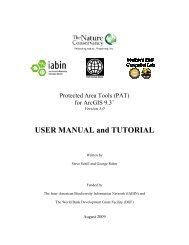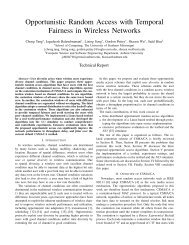Create successful ePaper yourself
Turn your PDF publications into a flip-book with our unique Google optimized e-Paper software.
Source: From Save Our Coral Reefs, an educational manual published by Ocean Voice International,<br />
Ottawa, Canada. Used with permission.<br />
53. <strong>MAKING</strong> <strong>FISH</strong> <strong>AND</strong> <strong>SHELL</strong> <strong>PRINTS</strong>: <strong>GYO</strong>-<strong>TAKU</strong><br />
Methods that enable a natural resource to be re-used several times to make saleable objects are much<br />
gentler to the environment than methods where thousands of animals are sold directly, as in shellcraft.<br />
Fish and shell-printing is one such gentle craft. Fish and shell-prints, printed in color on fine paper, are<br />
craft-items enjoying a growing interest amongst American and Japanese tourists.<br />
Gyo-taku is a method of making a print or illustration of an object using the object itself. Fish,<br />
molluscs, leaves and other natural objects may be used for gyo-taku. In the direct method, the object<br />
is lightly and evenly linked or painted. The painted object is then pressed against paper, leaving behind<br />
an image. If the object is rounded, then the object may need to be rolled up and down or back and<br />
forth to print the whole surface. If the object is rolled, take care that it is not shifted during rolling or a<br />
double image may be printed. In the indirect method, the object is wrapped smoothly in paper and a<br />
piece of cloth lightly dipped in ink or paint, is rubbed over the outside of the paper; paper over ridges<br />
and bumps on the object are inked more heavily, “valleys” remain white.<br />
What do you need to make gyo-taku? Obtain a quality paper that will last well, has a nice color and<br />
texture. Choose a paint or ink that is non-toxic (not poisonous)—then afterwards, if desired, a fish<br />
used for printing can be eaten, and it will be safe to leave the ink or paint around the house where there<br />
are young children. Find inks or paints that will not bleach when exposed over time to sunlight. With<br />
good paper and permanent-style ink, the purchaser of the gyo-taku will then be able to enjoy the print.<br />
for many years. Chinese or Japanese sumi ink or India Ink can be used for black; non-toxic artist’s<br />
water colors, poster colors or gouache can be used for colors.<br />
A clean dry shell requires no previous preparation. But a fish should first be wiped clean with a cloth so<br />
there is no mucus or moisture on the skin. The object to be printed, is covered with ink using a brush or<br />
a wad of cloth lightly dipped in ink or paint. Only the raised higher points are inked, the grooves and<br />
crannies are left free of ink. The object is then pressed firmly on the<br />
paper and lifted off, or carefully rolled once if it is rounded. With a<br />
fish, the fins can be spread out carefully and pressed separately<br />
against the paper. The print can then be left to dry. The name<br />
of the mollusc or fish, your town and province, and the artist<br />
can be neatly written on the print.<br />
By treating the fish carefully a number of prints can be<br />
obtained. If non-toxic ink has been used, then the fish can<br />
be washed, skinned and cooked. The hard structure of shells<br />
lets them be used any number of times as a printing stamp. You<br />
could sell one shell a hundred times this way!<br />
Once the simple method of gyo-taku has been mastered, you can try fancier<br />
ones. If the fish you are using has stripes, like a Moorish idol, then just paint the stripes, or paint two or<br />
more colors on the fish for printing, matching the natural colors on the fish. It is also possible to make<br />
simple scenes using fishes, seaweed and shells to print the picture. Or you may wish to add value to<br />
your print by mounting it on paper, making a matte, framing it with wood or bamboo, and covering the<br />
print with glass or plastic.
A damp cloth to wipe the fish clean, sumi ink, a brush or wad of cloth to spread the ink on the fish, and suitable<br />
paper are needed to make a gyo-taku or fish print.<br />
Correlation to National Standards from McREL ( http://www.mcrel.org ) :<br />
Geography<br />
16. Understands the changes that occur in the meaning, use, distribution and importance of resources<br />
Visual Arts<br />
1. Understands and applies media, techniques, and processes related to the visual arts<br />
4. Understands the visual arts in relation to history and cultures

















